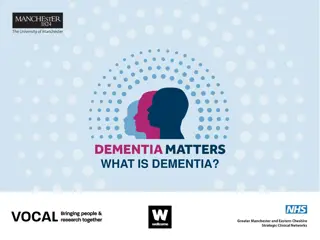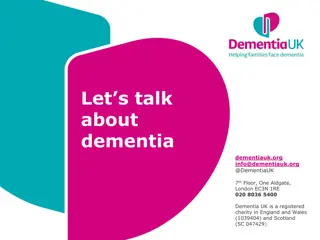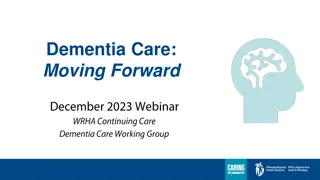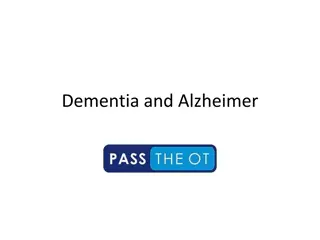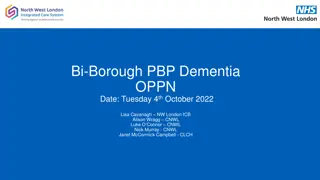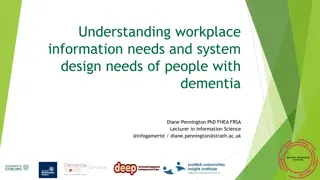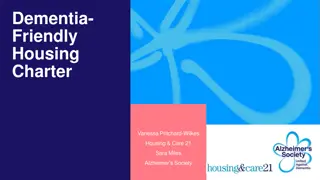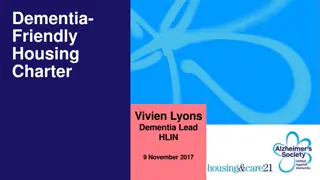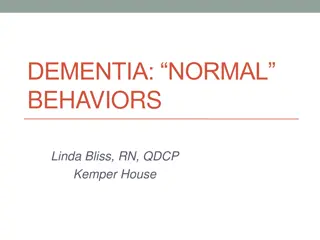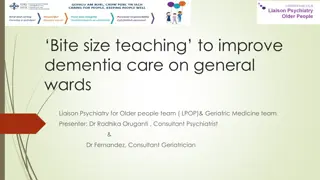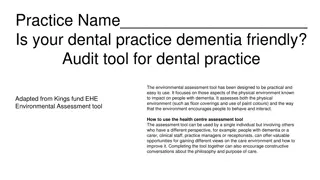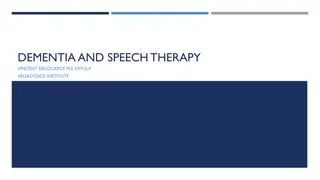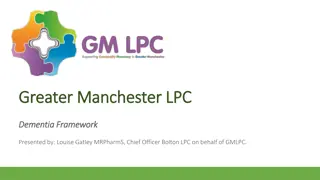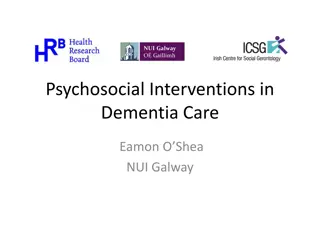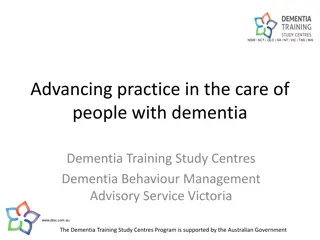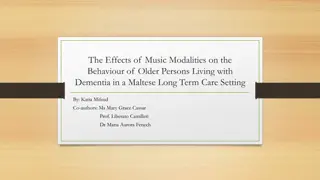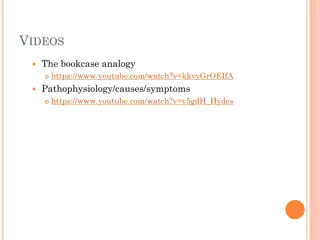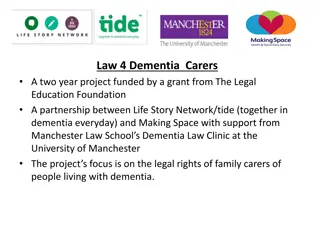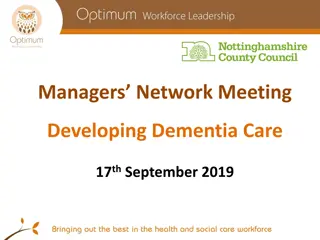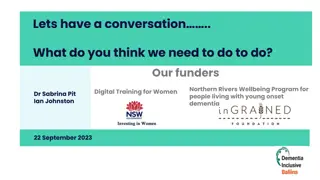Enhancing Dementia Care through Goal-Directed Approaches
This content delves into the importance of goal-directed care in improving the quality of life for individuals with dementia. It covers shifting the focus of care from disease-based to person-centered approaches, outlining the goals of dementia care at different stages, and emphasizing the value of considering individual and family values in care decisions. The training goals aim to enhance family involvement and promote person-centered care, ultimately guiding discussions to establish effective care practices.
Download Presentation

Please find below an Image/Link to download the presentation.
The content on the website is provided AS IS for your information and personal use only. It may not be sold, licensed, or shared on other websites without obtaining consent from the author.If you encounter any issues during the download, it is possible that the publisher has removed the file from their server.
You are allowed to download the files provided on this website for personal or commercial use, subject to the condition that they are used lawfully. All files are the property of their respective owners.
The content on the website is provided AS IS for your information and personal use only. It may not be sold, licensed, or shared on other websites without obtaining consent from the author.
E N D
Presentation Transcript
Goal-Directed Care: Identifying & Using Values to Direct Care Decisions Partnerships to Improve Care and Quality of Life for Persons with Dementia
Goals of Training Goals for series Enhance family involvement in the daily care of loved ones with dementia Promote person-centered care Goals for today Defining goals of health care and treatment Consider individual and family values in relation to goals Establishing practices to guide family discussions
Shifting Focus of Care Disease-based care Goal-directed care Identify & treat specific diseases May be person-centered; often provider directed Focus on curing disease, restoring health Best use: acute illness, younger age, long life expectancy Determine person-family desired outcomes Always person centered; family as proxy in dementia Focus on quality of life, comfort, enjoyment living Best use: disabling diseases like dementia; limited life expectancy
Goals of Dementia Care Goals shift as dementia-related disability increases Early in dementia Less cognitive impairment; better quality of life Greater focus on health promotion & preventing other illness Often full treatment of health problems Later in dementia Declining function interferes with quality of life Less emphasis illness prevention and treatment to prolong life Greater focus on comfort-care
Review: Stages of Dementia Late Early Middle Cognitive Little purposeful activity; extensive assistance is needed Cognitive Forgetfulness, losing things, difficulty planning Cognitive Increasing confusion, difficulties with activities of daily living, behavioral symptoms General Health Increasing number/ severity of health problems Impaired function Shorter life expectancy Focus on safety, well- being, quality of life Goals guide decisions General Health Complications are common: infection, choking Short life expectancy Focus on comfort, symptom management Decrease treatments Use palliative care General Health Physical health problems not prominent Physically functional Focus on health promotion, prevention Treat health problems
Collaborative Goal-Setting Uses same principles as partnership agreements! Identify desired outcomes or aim of care/treatment No one right way; approach varies by care setting Set a goal Develop action steps Evaluate outcomes Relies on . . . Back and forth discussion: family/person and staff/providers Mutually agreeable action plan Clear to all: precise, realistic, doable Communicated to other staff and family members
Collaborative Goal-Setting Concentrates on PERSON-centered care! Includes person with dementia, if possible Early discussions promote shared viewpoints Values and beliefs can guide later decision-making Help families act as proxy informant, decision-maker Respects PERSON and FAMILY s values, beliefs Clarifies proxy decision-maker Aims to avoid crisis-driven decision-making
Goal-Setting Starts with Values Values What matters most? Motivate our actions/decisions Relationships, connections with others Spirituality/religion Productivity, personal growth, recreation Health, wellness, symptom management Balancing quantity and quality of life Dignity, self-sufficiency Underlying beliefs and convictions
Move from Value to Goals Goals Describe HOW a person lives according to what matters most to them Meaningful goals: SMART + Based on values: Linked to what matters Specific: Easy to understand and follow Measurable: Outcome is clear Attainable: Realistic, doable Relevant: Fit needs; flexible Time-bound: Reviewed at set times Detailed description of activities or states
Three Broad Goals of Care Survive as long as possible Prevent illness, promote health, treat disease Live as comfortably as possible Treatment focused on relief of pain, suffering Avoid burdensome, uncomfortable treatments Combination of the above Accept some treatments Avoid ones that are burdensome Focus on comfort
Dementia-Related Goals of Care Goals identified by family caregivers 1. Medical care and end of life Doesn t get burdensome medical care Has doctors/providers who work with us (family) Doesn t take medicines with side-effects Stays out of the hospital 2. Quality of Life Physical Is physically safe (e.g., avoids falls) Lives at home/preferred setting
Dementia-Related Goals of Care, cont. 3. Quality of Life Is able to socialize with family/friends Keeps mind stimulated 4. Accessing Services and Support Have legal issues in order Find community resources for dementia 5. Caregiver Support Family caregiver has more free time/respite care Family caregiver is able to control frustrations Social and Emotional
Collaborative Goal-Setting: Not Easy! Person/Family Providers/Staff Goals are difficult to describe Expect provider to make decisions Goals change Situations change Goals are unrealistic Goal focus on others (not part of care team) Culture focused on treatment and cure vs. quality of life Not trained in shared goal- setting Conversations remain vague Live longer Be healthy Not SMART Outcomes don t change
Use Partnership Principles Identifying values and goals are key to partnerships!! Include in family education/orientation Review disease course/changing treatment options Discuss early to avoid stress later Identify values that guide goals Emphasize importance of goals in partnership agreements Who will do what? When? What outcome is desired?
Goal-Setting in Partnerships Information-sharing and NEGOTIATION are keys! Clarify broad life values: What matters most Use back and forth process to discuss goals, actions, outcomes Identify pros and cons of care/treatment options Confirm Priorities may change over time! Plans are never written in stone As before! Not all staff have the same roles, As before! Not all staff have the same roles, but work as team!! but work as team!!
Goal-Setting in Partnerships Factors to consider in Pros and Cons Hospitalization Confusion of transport, change in environment/staff Can treatment be provided in current setting? Preventive health/screenings Discomfort of screening process (e.g., rectal exam) Would the person be a candidate for interventions? Medication use Number of medications used early to extend life Is the regimen needed now? Can some be discontinued?
Advice from the Field Have conversations early and often Start on admission and include in care /service plan meetings Talk about changes in function that may be coming as the disease progresses Discuss family roles: power of attorney, proxy decision-maker Discuss specifically what is/what is NOT provided in hospice care
Summary Identifying broad life values helps set goals of care Goals will change as dementia progresses Early, clear, and ongoing discussions are essential Promote comfort and quality of life for person Avoid crisis-based decisions Advance positive relationships between staff and family Key to effective staff-family partnerships!
Coming up next Hospice Approach to Dementia Care Family Involvement in Advance Planning


